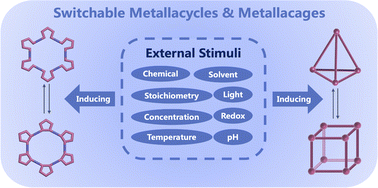Switchable metallacycles and metallacages†
Abstract
Two-dimensional metallacycles and three-dimensional metallacages constructed by coordination-driven self-assembly have attracted much attention because they exhibit unique structures and properties and are highly efficient to synthesize. Introduction of switching into supramolecular chemistry systems is a popular strategy, as switching can endow systems with reversible features that are triggered by different stimuli. Through this strategy, novel switchable metallacycles and metallacages were generated, which can be reversibly switched into different stable states with distinct characteristics by external stimuli. Switchable metallacycles and metallacages exhibit versatile structures and reversible properties and are inherently dynamic and respond to artificial signals; thus, these structures have many promising applications in a wide range of fields, such as drug delivery, data processing, pollutant removal, switchable catalysis, smart functional materials, etc. This review focuses on the design of switchable metallacycles and metallacages, their switching behaviours and mechanisms triggered by external stimuli, and the corresponding structural changes and resultant properties and functions.



 Please wait while we load your content...
Please wait while we load your content...